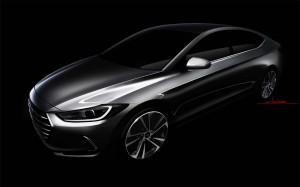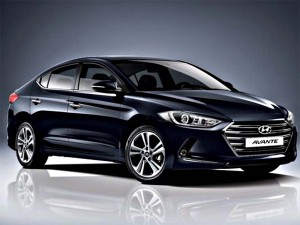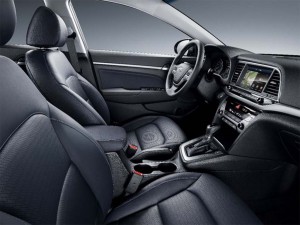We’re not supposed to see the all-new Hyundai Elantra until it makes its splashy debut at the L.A. Auto Show in November. But if you ignore the “Avante” badge on the new mode that has just been unveiled in the Korean carmaker’s home market, well, you’ve got a good guess of what the new Elantra will look like.
For those who were disappointed when the latest-generation Hyundai Sonata adopted a more conservative design, don’t worry. The new Elantra maintains the edgy styling that made it such a standout in the traditionally stodgy compact sedan segment when the current model debuted a few years back.
The new Hyundai Elantra will also grow a wee bit larger, add a variety of new high-tech features – such as emergency auto braking — and likely deliver a little bit better performance and fuel economy.
“With the pursuit to achieve world’s best technology, the newly introduced all-new Elantra was developed with concerted efforts of all our employees at Hyundai Motor,” said Woong-Chul Yang, vice chairman of Hyundai Motor Group’s R&D Center during the sedan’s Korean debut.
(Click Herefor a complete round-up of the 2015 Frankfurt Motor Show.)
Long lost in the crowd, the Elantra has become one of the segment standouts, and Hyundai clearly wants to retain its image of design leadership. If anything, the Korean Avante reveals a new front-end design, with a larger hexagonal grille and narrower headlamps. There’s a new body-side crease that flares off the front wheel wells and stretches to the wraparound taillights. And the overall shape is that of a fastback, rather than conventional sedan.
The basic dimensions undergo some minor changes. The next Hyundai Elantra will measure about one inch longer, bumper-to-bumper, though it will retain the current 106.3-inch wheelbase. Passengers will get a wee bit more shoulder room, as well, as the sedan will be an inch wider – though it’s also 0.4 inches lower.
Expect to see the American model hold to similar dimensions, possibly tweaking the length ever so slightly to compensate for U.S. bumper regulations. The new Elantra, like other recent Hyundai offerings, is making much more extensive use of high- and ultra-high-strength steel alloys, and that should translate into a stiffer body, improved road dynamics, increased safety performance – and lighter weight.

This rendering offered a first official glimpse of the direction Hyundai will take with the next Elantra.
We’ll likely have to wait for the L.A. Auto Show to see what that will mean for fuel economy, but like its competitors, Hyundai has been pushing to improve those numbers to meet tough new mileage standards.
(Hyundai reveals new “N” performance line. Click Here for more.)
The Korean Hyundai Avante is debuting with three engines:
- A 1.6-liter direct-injected inline-four making 130-horsepower and 119 pound-feet of torque;
- A 2.0-liter four using the fuel-stingy Atkinson cycle, making 147-hp and 132 lb-ft; and a
- 1.6-liter diesel that we aren’t likely to see here in the U.S. market.
No word on plans for a hybrid model, though that apparently is in the works.
The Avante version will include emergency auto braking, a technology we’re likely to see in the U.S. soon, if not at launch. Just this month, a coalition of 10 automakers announced plans to make the technology standards on all of their American models. And while Hyundai was not among that group, it will be under heavy competitive pressure to follow suit. The new Elantra will likely also offer blind spot detection, auto high beams and rear cross-traffic alert, either as standard or optional equipment, depending upon the model.
Though it confirms the L.A. launch plans, the Korean carmaker hasn’t yet said whether the new Hyundai Elantra will reach market here as a 2016 or 2017 model.
(Hyundai Vision-G Concept hints at radical design shift. Click Here to check it out.)


